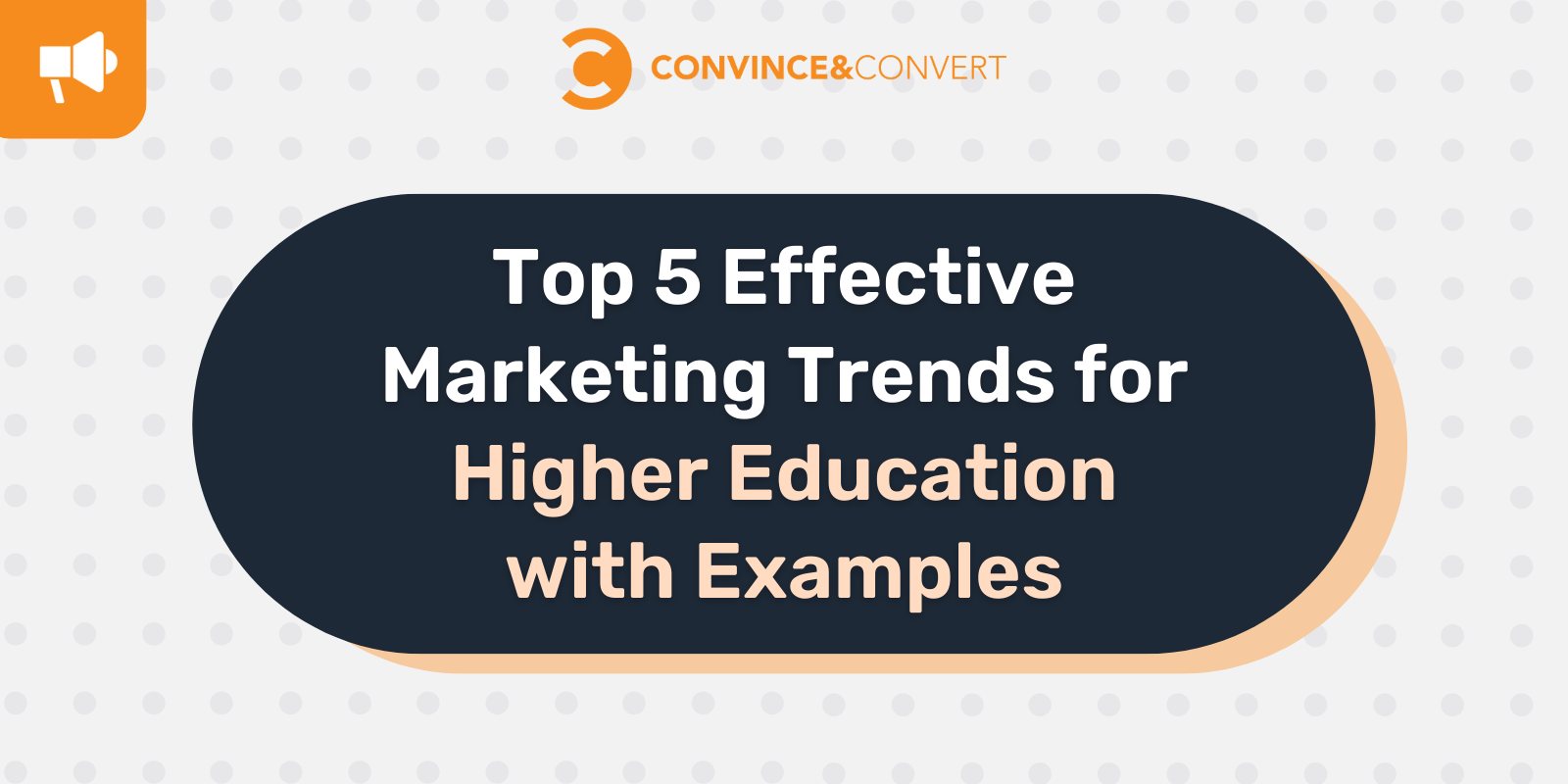
Forty-one percent of prospective U.S. college students feel unsure about enrolling in college. A 2022 Edge Research found that prospective students may have delayed enrolling because of psychological factors such as the fear of a “too stressful” college life, among other concerns.
Higher ed marketing teams have to do more than just highlight their degree programs. Students are concerned with factors such as student debt, inclusivity, and a school life without “too much pressure”.
SimpsonScarborough reports that the average institution spends between $29 and $263 to enroll one student. With such a high marketing spend, your marketing strategy should be effective, actionable and give you a tangible ROI.
This article covers the top five most effective higher ed marketing trends and provides actionable tips to try out each today.
The 5 Top Trends for Higher Ed Marketing Trends to Try Out Today
Social media plays a big part in marketing today. In fact, 97% of Gen Z learn new products through social media. Besides the tested traditional channels, social media marketing is a higher education marketing trend that will be here for a while.
Here’s a list of our top most effective marketing trends you can use to target prospective college and university students:
1- Invest in a Dynamic Blog
Blogging is a cost-effective way that higher education institutions can use to showcase thought leadership and increase online visibility. Blogging helps you deliver consistent messages and curve a preferred niche for your institution.
You can use blogs to spotlight your programs and courses. With blogs, you can share authentic and compelling stories—and humanize your learning institutions. And, blogs can easily be repurposed for other content types in your content strategy, such as social media content, email and video scripts for better distribution.
Tips for a successful higher education blog
A university blog should build awareness of the available programs, engage the right target audience, and provide valuable information. Here are tips to make your institution’s blog stand out:
- Focus on valuable and informative content. Relevant content may include career prospects in specific industries, educational trends, and insights.
- Share student success stories, including real-life experiences and achievements.
- Create blogs on study tips and resources to attract students looking for effective study tips.
- Publish blogs on industry insights for various industries and sectors and how your programs are relevant and practically applicable.
- Target relevant keywords for SEO and online visibility to attract organic traffic.
You can also leverage community engagement and highlight interactions on your blog. Promotions and announcements such as partnerships, scholarships, and events keep your audience informed.
7% of Gen Z learn new products through social media. Click To TweetExamples of successful higher education blogs
A blog’s success relies greatly on relevance and the quality of the content published. Here are two examples of higher education institutions’ blogs.
Example 1. Arizona State University
Arizona State University is a public university located in Tempe, Arizona. They offer many programs including business, law, engineering and more. The institution uses blogs to share education-related content and thought leadership.
They also share their research and innovation programs and projects including budgets and research facilities to inspire aspiring students and corporate partners.
Having carved a niche in sustainability and research, the Arizona State University blog provides exhaustive information for aspiring students across various disciplines.
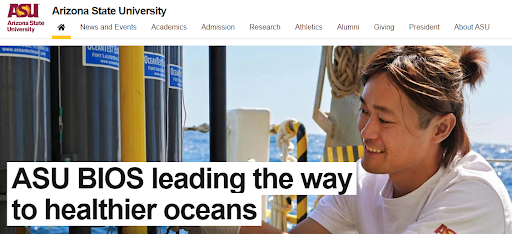
Example 2: WGU
WGU is a fully online university that offers competency-based degree and certificate programs. The university runs a robust blog detailing all its degree programs, skills, and different career options students can pursue after taking their courses.
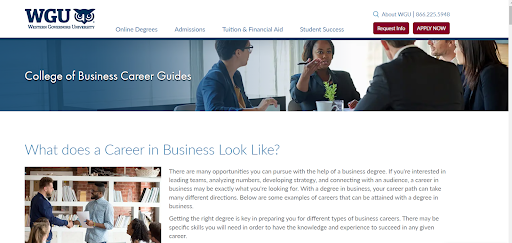
2- Leverage Short-form Videos to Showcase Your Institution
Just like their name, short-form videos are quick and easy to consume. They are low-commitment, and someone is more likely to watch the entire video without skipping. With short-form videos, you eliminate fluff and capture even audiences with short attention spans.
Short-form videos like TikTok, Instagram Reels, and YouTube Shorts help you to keep up with trends. The bite-sized videos also have the potential to become viral—and you can easily connect with younger audiences and promote your institution.
Tips for creating effective short-form marketing videos for higher education
- Focus on user-generated content, such as student influencers, for relevance with your target audience.
- Keep the videos concise and engaging—bold visuals, trendy music, interesting stories, and more to keep the viewer interested.
- Highlight campus culture, such as student experiences, to showcase your university’s personality.
- Optimize your videos for social media using appropriate hashtags, titles and descriptions.
- Add a clear call to action to encourage the viewer to take action. Ensure your details are captured clearly since short-form videos have the potential for virality and can be shared beyond your pages.
You can also have a mix of short-form and longer videos to showcase key information about your institution. For instance, research shows campus tours are a key determinant of student enrolment. Videos help you showcase your institution virtually.
Examples of universities using short-form videos effectively
Today, institutions use short-form videos to showcase campus life, student experiences, and academics. Here are a couple of examples.
Example 3: University of Utah
The university has hundreds of videos on TikTok, showcasing different aspects of the university, and has garnered close to half a million likes on the platform. The university also has over 800 videos on YouTube, combining long and short-term videos.
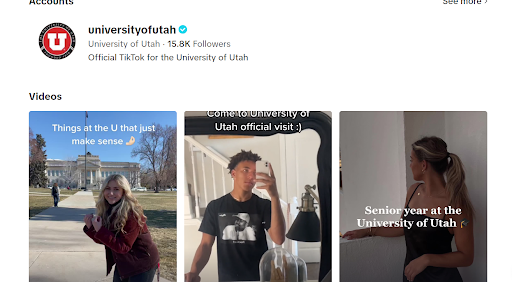
3- Collaborate with Influencers and Student Ambassadors
Influencer partnerships provide a unique way to reach wider audiences who may not be aware of your traditional channels. Using student ambassadors showcases authentic experiences within your university, helping you build trust and social proof.
Student influencers can help you in targeted marketing campaigns and produce creative content, breathing new life into your marketing efforts.
Tips for creating the right influencer partnerships for higher education
Your current and former students can be your brand ambassadors. An Institute of International Education survey reported that 68% of US colleges are employing their students to reach new markets.
Besides relying on current and former students, you can partner with influencers to reach prospective students and enhance your visibility. Here’s how to go about higher ed influencer partnerships:
- Clearly define your goals—e.g., boost enrollment, increase online visibility, content alignment, etc.
- Consider an influencer whose audience aligns with your target demographic. You can factor in their age, location, social media platform, academic aspirations, etc.
- For an authentic, relevant partnership, consider influencers that have a genuine connection to education, research, personal growth, and other similar college goals.
- Track and measure the success of your influencer campaigns with metrics such as website traffic, applications submitted, engagement rates, etc.
Examples of Higher Ed institutions using Influencer partnerships successfully
Influencers can drive traffic to your website, promote your social media channels, or become long-term advocates for your institution. Here are examples of higher ed influencer marketing:
Example 4: University of Southern California
The university has various active TikTok accounts focusing on different topics including education, fashion, football and athletics.
The institution regularly partners with influencers to promote their college activities , with each video getting thousands of views, comments and shares.
The influencers naturally promote the institution when doing everyday, relatable activities like putting on make-up, walking around campus and showcasing what an actual day in USC looks like.
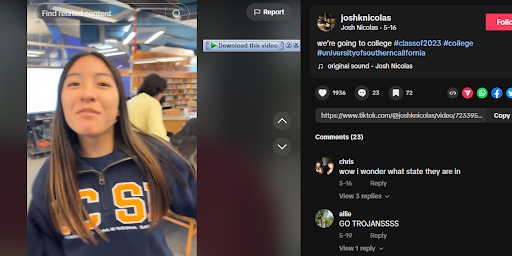
4- Use PPC Advertising to Generate High-Quality Leads
Pay-per-click (PPC) ads are a great way to target and retarget potential students. With keyword research, you identify potential keywords and phrases that potential leads may be using when searching for higher education programs. You create relevant ads to ensure your ad appears on search results when potential students search for similar content.
Unlike organically-driven traffic, you can narrow your target audience with PPC to age and other demographics. You can then get quality leads and higher conversion for your marketing efforts.
PPC advertising tips for the higher education
PPC campaigns require continuous monitoring, optimization, and adjustments for good performance. But, strategically selecting relevant keywords that align with your courses and programs and fine-tuning audience demographics and interests, you can maximize the reach and impact of your ads.
- Use Google’s Remarketing lists for search ads (RLSA) to tailor your search ads and reach users who are already familiar with your brand.
- Combine PPC with responsive ads to access wider audiences, fit ads to different platforms, and get optimal ad performance.
- Segment your campaigns based on program type, degree level, or target audience to create more tailored ads and landing pages.
- Write compelling and relevant ad copy, highlighting your institution’s unique selling points (USPs) and benefits. Optimize the dedicated landing pages to match the messaging on your ads and for SEO.
Examples of Successful PPC campaigns for Higher Ed institutions
PPC campaigns can help your institution gain visibility fast. To measure the effectiveness of your PPC campaign, set KPIs that align with your objective and regularly monitor your metrics. E.g., the click-through rate (CTR), Conversion rate, number of applications filled, etc.
Here is an example of a successful higher ed PPC campaign:
Example 5: Bellevue University
Universities are increasingly using PPC advertising to further their traditional and organic marketing efforts.
A simple query on “MBA Degree ” or “online MBA” brings up Bellevue University on top of the organic content. The university has also targeted keywords like “online cybersecurity degree”, “MBA in USA for international students” , and other long tail keywords.
The university also uses the same landing page for all the different queries, making monitoring their KPIs easier.
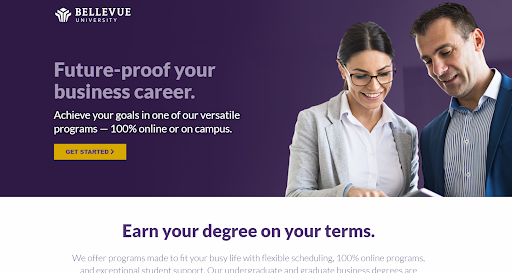
5- Leverage Diversity, Equity, and Inclusion in Your Marketing Efforts
Diversity, equity, and inclusion (DEI) in higher ed is an intentional effort to showcase your institution as an environment that values and supports individuals from diverse backgrounds, identities, and experiences.
DEI helps you encourage a sense of belonging, representation, and equal opportunity for all members of your community regardless of what makes them different such as ethnicity, gender, religion, and other aspects of diversity.
Gen Z cares about diversity and inclusion in marketing. A study by Microsoft reports that inclusive ads led to a lift in purchase intent—even when the person viewing the ad was not personally represented in the ad.
Incorporating DEI in your marketing helps send a clear message that your institution values and respects everyone’s uniqueness. You also attract a diverse community and provide a rich learning experience, producing culturally competent graduates for our interconnected world.
Tips for Promoting Diversity, Equity, and Inclusion in your Higher Ed Marketing Campaign
- Showcase diversity in various marketing materials such as brochures, websites, social media posts, and videos. Represent your institution accurately and demonstrate the commitment to DEI.
- Use inclusive language and imagery by creating content that resonates with diverse audiences and makes everyone feel valued and respected. e.g., you can use gender-neutral pronouns to avoid stereotypes.
- Highlight your institution’s efforts towards equity and inclusion. e.g., scholarships offered to minority students, faculty on inclusive teaching practices, etc.
Capitalize on Higher Ed Marketing Trends
The higher education marketing landscape is undergoing a remarkable transformation, driven by technological advancements and shifting student preferences.
Adopting innovative approaches like virtual tours and influencer partnerships will help you connect with prospective students. And, data insights will help you create personalized marketing strategies, such as offering tailored messages and experiences to create a meaningful connection with each prospect.
Ultimately, remain adaptive and innovative in your marketing efforts to get the next generation of learners in a declining market.


